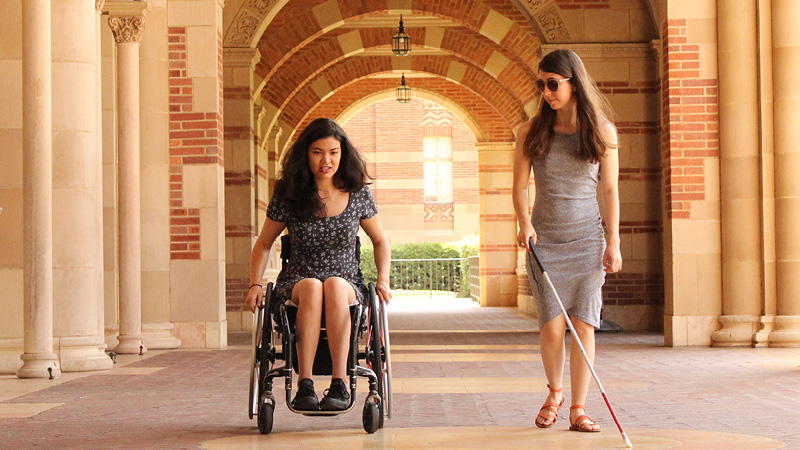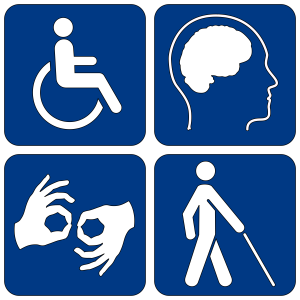Making Accessibility a Top Priority in UCLA’s Digital Spaces

But to what extent is this reflected in other spaces where we spend much of our time — our smartphone screens, laptops and desktops?
“The accessibility of digital spaces is equally as important as the accessibility of physical spaces because of the amount of time we spend there and how integral digital spaces have become in our day-to-day lives,” said Travis Lee, coordinator for the UCLA Disabilities and Computing Program (DCP).
With the COVID-19 pandemic upending the traditional work environment and ushering in remote jobs, instruction and even online socialization, more and more of our lives are taking place in the digital realm. Computers, phones and other digital devices are the new frontier in ensuring equal access for all.
“Trying to be more inclusive to people with disabilities will improve STEM in the future,” Travis Lee said.
One-quarter of the adult population in the United States lives with disabilities, according to the Centers for Disease Control and Prevention. While the regulations surrounding accessibility in physical spaces regarding ramps or elevators, for instance, have clear guidelines, Lee said, the requirements for digital accessibility are not as readily met.
So how does one make digital information more accessible?
“The best way to become more accessible is to actually think about all of those types of end users from the very beginning,” Lee said.
For example, those who are visually impaired may not be able to read small or highly stylized fonts or may require higher color contrast on a webpage. Others with fine-motor issues may not be able to control a computer mouse and thus are reliant on keyboard strokes or clear image descriptions. If such considerations are incorporated at the beginning of a website design process, then the finished website will be more accessible, Lee said.

“I remember that being a really eye-opening experience to me that what I was doing was discriminatory,” Lee said. “So what I decided to do at that point in 2011 was to devote a large portion of my time to understanding the disabled experience in online education.”
Now, as a coordinator for the DCP, Lee helps ensure all UCLA websites are as accessible as possible. To achieve this goal, the DCP offers website consulting, testing and review services for various campus units. The office employs several students from the School of Engineering to help with these efforts.
Jacob Linder is a third-year computer science student who has been working for the DCP for about five months and is already making a difference in UCLA’s digital accessibility. Linder is designing a UCLA theme and plug-in for the website builder WordPress that will allow campus organizations to quickly and easily build their own accessible websites.
“With this approach, there will be an ensured consistency of UCLA-styling across the many UCLA-affiliated websites,” Linder said. “Additionally, we can ensure that the components used within these websites are accessible.”
While he only recently started his job upon the recommendation of a roommate who also worked with DCP, Linder said he finds the work rewarding.
“I believe that the work we do here is important and can help much of the student body, especially students with disabilities, and so it was nice to find a job that has a positive impact on other students,” Linder said.
First year civil engineering master’s student Katie Osborn said her work at DCP has made her more aware of accessibility outside of the academic context.
“After spending time creating training material on course remediation, I can’t help but notice accessibility issues within websites, Instagram posts, and applications that I see and use in my own time,” Osborn said. “It has definitely made me question why a universal standard for web accessibility isn’t enforced across the globe, especially as technology has become such an important facet of human life.”
“I hope to see DCP continue to branch out in other sects and increase partnerships with organizations on campus,” said Peter Agban.
DCP also works with other organizations at UCLA that promote the interests of students with disabilities to achieve other goals, such as improving UCLA’s online education options and increasing awareness of issues confronting people with disabilities.
“I hope to see DCP continue to branch out in other sects and increase partnerships with organizations on campus,” said Peter Agban, a second-year aerospace engineering student and DCP accessibility engineer.
Another sphere of interest for DCP is data visualization. Scientific research revolves around collecting, visualizing and communicating data, but the ways in which it is done are not always the most accessible to people with disabilities as journal websites may not be designed with accessibility in mind or graphs of data may not have descriptive captions for visually impaired readers.
“Trying to be more inclusive to people with disabilities will improve STEM in the future,” Lee said. “The diversity of thought, the diversity of opinions, and diversity of life experiences will lead to better research outcomes for STEM.”
UCLA Samueli is working with DCP and other units on campus, including soliciting helpful input from students, to reexamine ways to improve accessibility on its websites and social platforms.
Natalie Weber contributed to this story.
